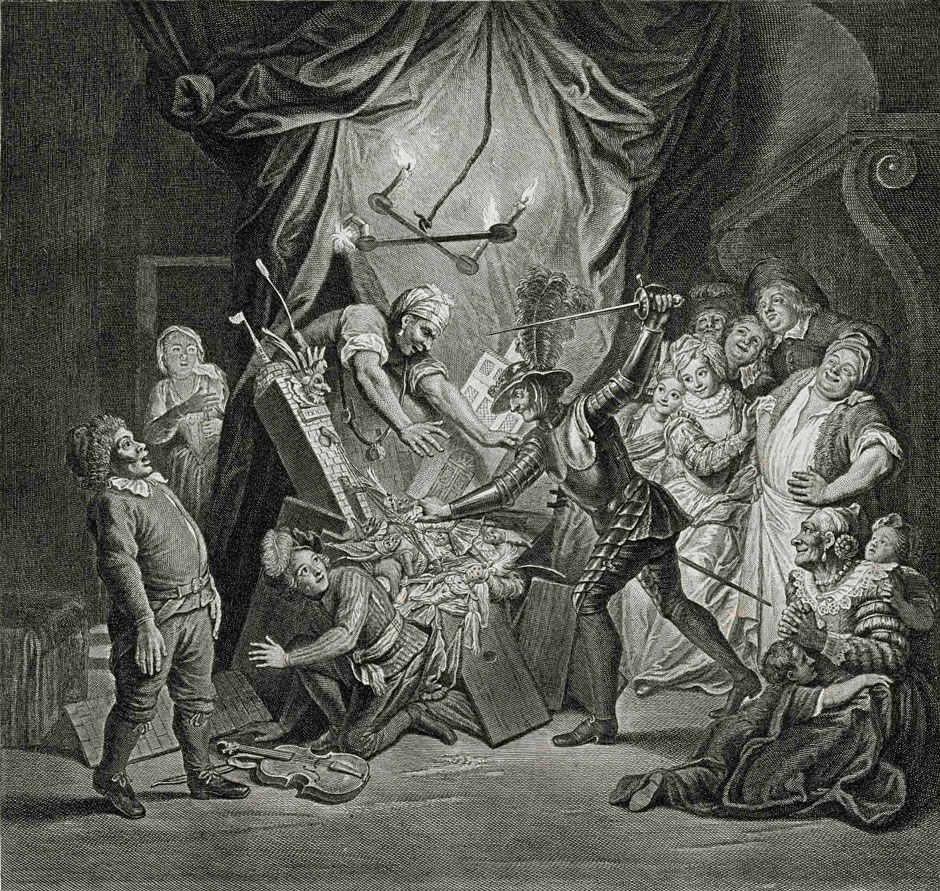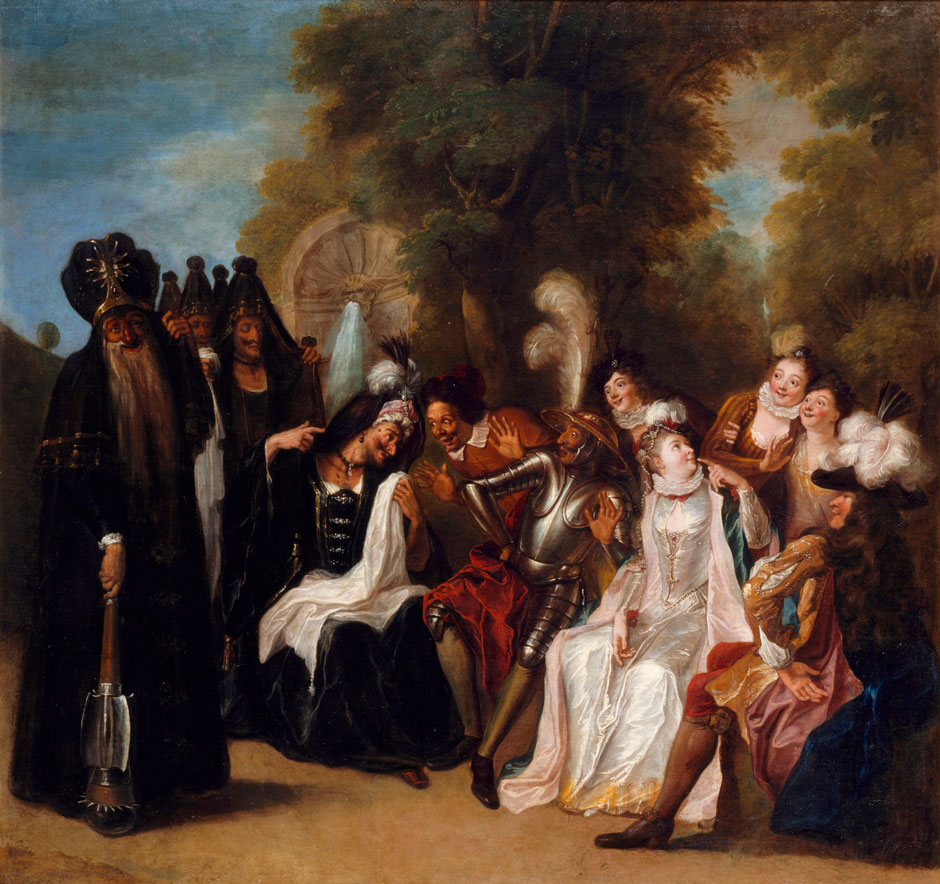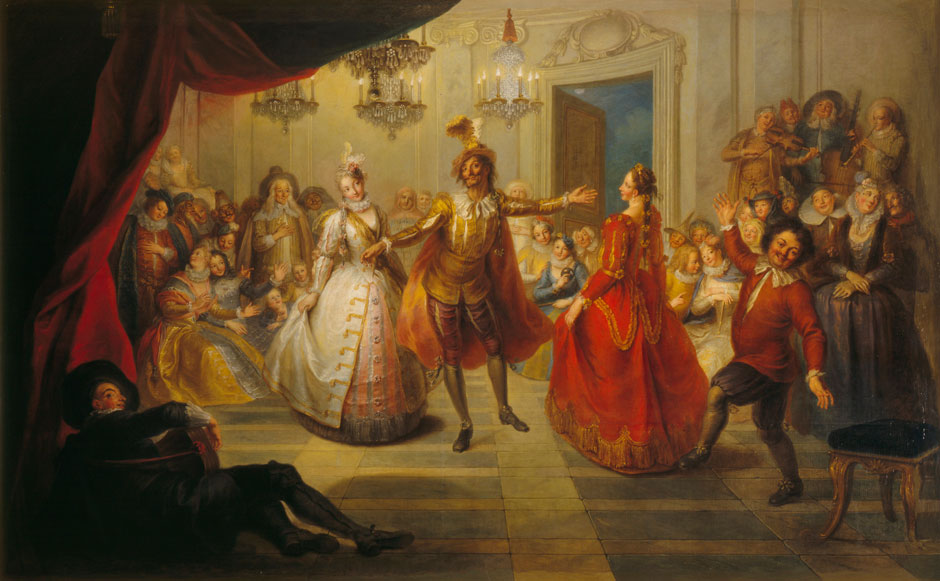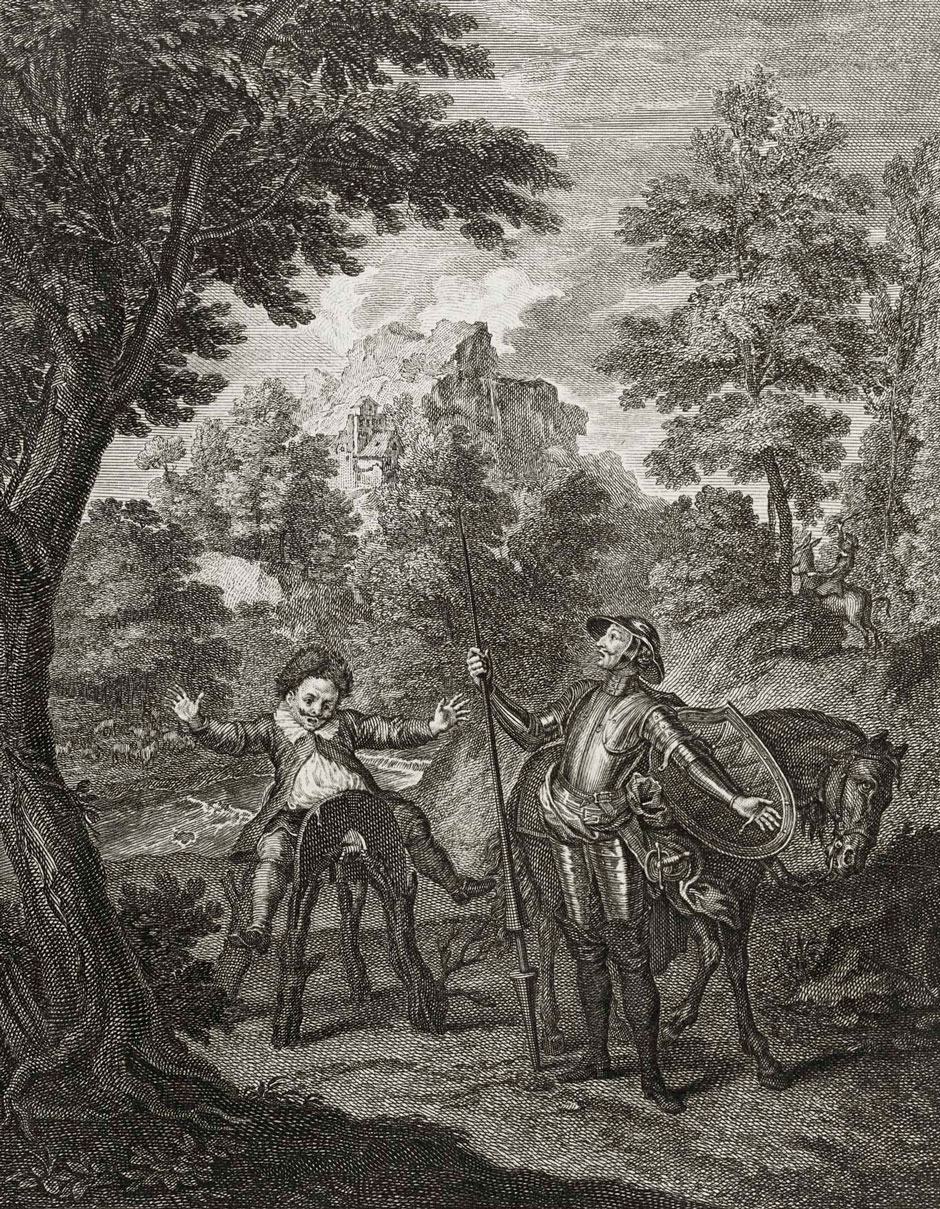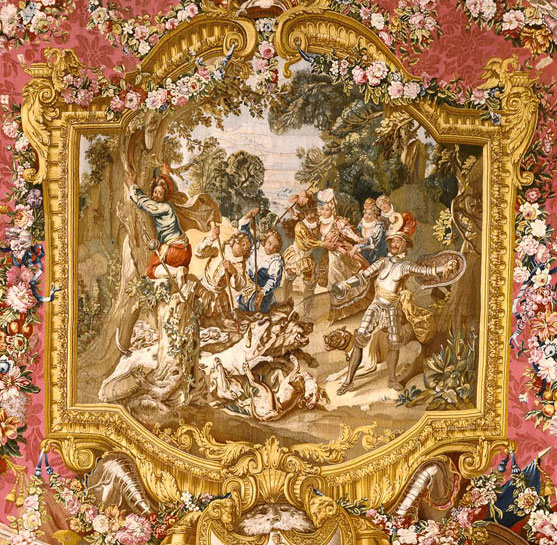Don Quixote lends itself to graphic treatment. The perplexed and comic hero and his sidekick, Sancho Panza, seem to enjoy throwing inwardness to the wind, an inwardness that might have interested a psychologist or a nineteenth-century novelist. Instead our two Spaniards appear in the sort of broad strokes that a painter who loved figures and groups might relish, or indeed a printmaker. They both get involved also in the type of scrapes and adventures that a good cartoonist could have invented. As they move through the countryside on their picaresque journey, they are, in our minds, all show and display, all stark image. Their each encounter suggests a group portrait with them at the center, and all around them figures with shocked expressions, undignified poses. The scenes they enact involve a clash between plan and misadventure, and also real hilarity and the inclusion of all classes.
Perhaps the engravings in early editions of the book itself and also the many images that the French painter and printmaker Honoré Daumier (1808-1879) made from the Quixote story have entered our imagination and made us see the Don on his horse, against the sky in a barren landscape, his pose self-important and purposeful but also strangely pointless, his spear held aloft as though he were a knight of old, and then behind him on a donkey comes the less stately Sancho Panza.
The Frick is running at the moment a small and brilliantly coherent show based on the relationship between the French artist Charles Coypel (1694-1752) and images from Don Quixote. Between 1714 and 1734 Coypel made twenty-seven paintings of moments from the novel (in 1751 he made one more), some of which are hanging in this show. The most distinguished French engravers of the age used these paintings for works that are also hanging close by. But perhaps the most significant and beautiful transformation of Coypel’s work on Quixote was done by the Gobelins Tapestry Manufactory. They made two hundred panels based on Coypel’s work. Three large, sumptuous, and elaborate examples of the Quixote tapestries are on display at the Frick as well.
Coypel, whose father and grandfather were also painters, began as a playwright. His play Don Quichotte was performed in 1712 when he was eighteen. His images of Quixote are so dramatic in their visual scope and use of space and color and contrast that they must have been a gift to both engravers and tapestry-makers. While they can be read as cartoons, work that was made specifically to be adapted for tapestry—and Coypel was paid accordingly—they also can be admired as paintings. Even today, despite having been restored several times in the eighteenth century, they are remarkable for the quality of their composition, for the odd and ingenious ways in which different characters, including minor players in the drama, have been depicted, the way in which nature and light, clothes and interiors have been painted.
Some of Coypel’s paintings have the same lightness and ease with bucolic imagery as the work of Jean-Antoine Watteau (1684-1721). Watteau was also interested in the theater, and it is easy to see in both painters a highly-developed concern with the delighted group or the picture with a figure at the center surrounded by men and women who are filled with curiosity and seem capable of abandoning good taste for the sake of good fun.
Coypel’s painting Don Quixote at Don Antonio Moreno Ball, for example, is inspired by a scene in part two of the novel. (Part two was published in 1615; the first part ten years earlier.) It is a soiree:
Among the ladies there were two with mischievous and jocund tastes, and although very respectable, they were somewhat brash in devising amusing but harmless jokes. They were so insistent on Don Quixote’s dancing with them that they exhausted him, not only in body but in spirit. Don Quixote was a remarkable sight: tall, scrawny, lean, sallow, wearing tight-fitting clothes, awkward, and not at all graceful.
Coypel has a field day with Don Quixote as the scrawny, graceless dancer, but he also loves the idea of the soiree itself; he has fun with the two women attempting to dance with the Don, including the woman on Quixote’s right whose magnificent dress is pearl-colored with much gold and rose-color at the cuffs and edges, with pink and silver rosettes. She is aware of her own allure. Coypel also seems to take pleasure from depicting the onlookers and spectators who are shamelessly amused as they gape and gaze. One woman is looking on with an expression on her face that is deeply suggestive. She is fascinated by Quixote; she seems quizzical but also oddly impatient, as though she wants the scene to go much further, to become even more diverting for the onlookers.
Advertisement
Since Coypel, as much as Cervantes, could work wonders with chance, mayhem, indignity, happenstance, and misadventure, there is a sense of him here as being a genuine kindred spirit with the novelist. Some images from the book must have been irresistible for Coypel. (In addition to reproducing the works on display, the catalog to the Frick exhibition gives us the passages from the novel on which they are based.) These include the moment in part two, chapter 39, when the women with beards appear. When they reveal their faces, they are “covered by beards, some blond, some black, some white, some variegated, at the sight of which it was evident that the duke and duchess were amazed, Don Quixote and Sancho stupefied, and all those present astonished.” At the right-hand side of this hilarious painting are two wonderful female figures chortling away to each other. They have rosy cheeks and looks of bemused wonderment. Don Quixote’s alarm is created with cartoonish exaggeration.
It is fascinating to move from these works so filled with vivid energy and theatrical force, to the engravings, with their more stable tone. The engravings, because of their use of shade, require much closer attention, but they too take sheer pleasure in the ludicrous, the absurd, and the highly staged. There is a sense here, as in the paintings, of a world that is shamelessly secular and free from guilt, ready to amuse itself and amuse us.
The tapestries are breathtakingly beautiful, signs of a high civilization. The Cowardice of Sancho at the Hunt was created in 1772. The Quixote narrative is contained as an image at the center. All around are floral designs and images of animals, created with great animation and a varied sense of texture. The color is exquisite. In the image Sancho is climbing up a tree to get away from the hunt. He is wearing red trousers and a look of alarm. Quixote has his armor on and is, as usual, ready to battle with man, beast, or thin air. Fashionable ladies are frightened. Dogs are snarling and barking.
The image has an extraordinary sense of drama and felt life. It has none of the thinness of many other tapestries, which often seem like mere decoration. On the contrary, these works manage to compete with the original Quixote paintings and also the engravings—suggesting with some justification that, as a medium, tapestry can handle feeling and drama, the human figure and narrative, with as much ease as painting, engraving, or indeed Cervantes’s novel itself.
Coypel’s Don Quixote Tapestries: Illustrating a Spanish Novel in Eighteenth-Century France is on view at The Frick through May 17.


